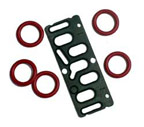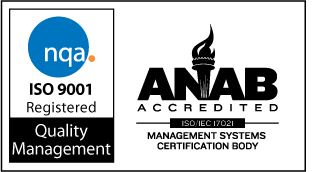
|
7108
S. Alton Way, Unit I |
(303) 758-2728
Home > Products > Rubber O-rings
Rubber O-rings
When we talk about "rubber" o-rings, we are using the term "rubber" to describe a whole host of o-rings that are made from a synthetic rubber-like material called an elastomer. We are not talking about o-rings made from natural rubber. Even though today the properties of natural rubber can be enhanced during the manufacturing process through a combination of adding ingredients to the liquid rubber mixture and then vulcanization or heating the mixture, the synthetic elastomers have superior properties over the natural rubber ones.
We offer all types of rubber o-rings from many compounds. We have rubber o-rings in a wide range of standard and non-standard sizes, everything needed for almost all sealing applications. One measures o-ring sizes by the inside diameter (ID) and the cross section (W). We carry all the standard sizes in the PSP standard sizes charts. In addition, we have many non-standard sizes in both inches and metric measurements. If we do not have the size you need, we can custom design and make anything you need.
We also provide rubber o-rings in many types of elastomers including FKM fluorocarbon, Kalrez®, Simriz®, nitrile (Buna-N), hydrogenated nitrile (HNBR), silicone, fluorosilicone, ethylene-propylene (EPR, EPDM), neoprene, polyurethane, ethylene propylene, and FEP encapsulated elastomers. We are certified by DuPont to sell Kalrez®. These rubber o-ring compounds can be manufactured by molding or extrusion as well as rubber to metal bonding. We can provide you with standard rubber products or customized molded rubber products.
Here are a few tips for rubber o-rings:
- The more extreme the temperature of your application, the shorter the life of your seal.
- Rubber o-rings for static applications are more forgiving and will work with a wider range of materials than dynamic applications.
- The higher the temperature, the more vulnerable your rubber o-rings are to harsh chemicals.
- When installing, do not stretch the seal more than 5% because you can lose seal compression.
- The maximum volume of the o-ring should never be more than the minimum volume of the gland.
- The groove depth must be less than the o-ring cross-section and the groove width must be larger than the o-ring cross-section.
- A general rule is to compress static o-ring cross-sections about 10% to 40% and dynamic ones about 10% to 30%.
- Coat the rubber seals with an o-ring lubricant before you install them.
- Use o-ring lubricants that are compatible with all the fluids in your application and do not use a lubricant that is made from the same material as the seal.
- You will not know for sure if your seals are right until you test them in your actual application.
By the way, if you were interested in buying rubber o-rings, here are some specifications that might be interesting to you:
- Natural rubber is a manufactured product from the juice of the Hevea rubber tree (which is actually latex). The manufacturing process includes adding other ingredients and vulcanization (heating the liquid rubber).
- The main use for natural rubber is for seals in automotive brakes plus food and beverage applications. It does not work well in hydraulic sealing applications.
- The temperature range for most compounds is -60° to +220°F, dry heat only.
- The hardness range is from 40 to 90 durometers.
We are located in the Denver Technological
Center in a suburb of Denver, Colorado
©1997-2017, Problem Solving Products, Inc.
Website Map | Privacy Statement
| Terms of Use

